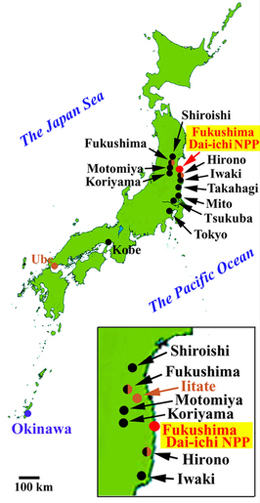Research Abstract
ヤマトシジミにおける福島原発事故の生物学的影響
The biological impacts of the Fukushima nuclear accident on the pale grass blue butterfly
2012年8月9日 Scientific Reports 2 : 570 doi: 10.1038/srep00570

福島第一原子力発電所の損壊では、大量の放射性物質が環境に放出された。この事故が動物に与えた生物学的影響を評価するための迅速で信頼性のある実験系はこれまでに考案されていない。本論文では、日本で一般的なシジミチョウであるヤマトシジミ(Zizeeria maha)に対してこの事故が生理的および遺伝的な障害を与えたことを明らかにする。我々は、第一化の成虫を2011年5月に福島地域で採集したが、その一部には比較的軽度の異常が認められた。第一化の雌から得られた子世代F1に認められた異常は重度が高く、それは孫世代F2に遺伝した。2011年9月に採集された成虫の異常は、5月に採集されたものと比較して重度が高かった。非汚染地域の個体に対する低線量の外部被爆および内部被曝により、同様の異常が実験で再現された。これらの結果により、福島の原子力発電所に由来する人為的な放射性核種がヤマトシジミに生理的および遺伝的な障害を与えたと結論される。
檜山 充樹1*, 野原 千代1*, 金城 聖良1, 平良 渉1, 儀間 真一2, 棚原 朗2 & 大瀧 丈二1
- 琉球大学理学部 海洋自然科学科
- 琉球大学 機器分析支援センター
*本研究は、檜山 充樹、野原 千代の2研究者が同等に貢献した成果として論文発表しています。
The collapse of the Fukushima Dai-ichi Nuclear Power Plant caused a massive release of radioactive materials to the environment. A prompt and reliable system for evaluating the biological impacts of this accident on animals has not been available. Here we show that the accident caused physiological and genetic damage to the pale grass blue Zizeeria maha, a common lycaenid butterfly in Japan. We collected the first-voltine adults in the Fukushima area in May 2011, some of which showed relatively mild abnormalities. The F1 offspring from the first-voltine females showed more severe abnormalities, which were inherited by the F2 generation. Adult butterflies collected in September 2011 showed more severe abnormalities than those collected in May. Similar abnormalities were experimentally reproduced in individuals from a non-contaminated area by external and internal low-dose exposures. We conclude that artificial radionuclides from the Fukushima Nuclear Power Plant caused physiological and genetic damage to this species.

